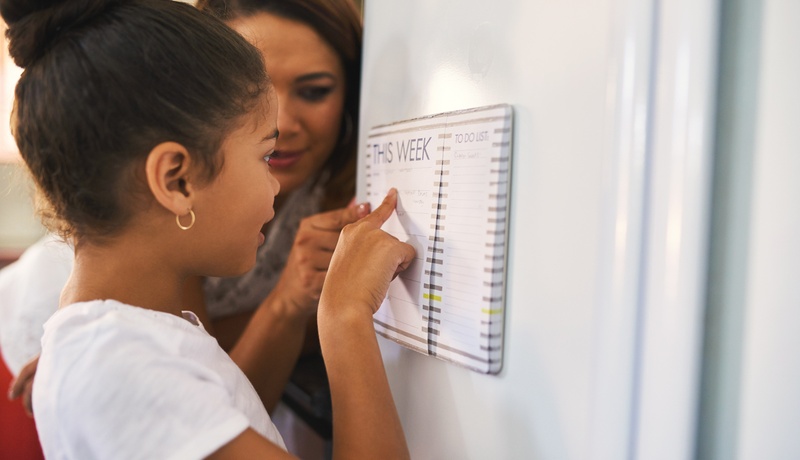Supporting Executive Function Weaknesses
Strategies for Organizing the Home and Family

Mornings, especially Monday mornings, can be quite chaotic for families. Lunches need to be made, shoes need to be found, and homework needs to be completed and sent back to school. For parents of children with AD/HD and other disorders impacted by executive functioning difficulties, these mornings can be even more hectic: they need constant reminders, struggle to find those missing items on their own, and forget that their social studies project is due that day. These issues occur due to the inherent difficulties of executive functioning weaknesses related to planning, managing time, adaptability, decision making, predicting consequences, and generalizing from previous experiences. Thankfully, there are numerous strategies available to parents to create a calmer, more organized home environment. Of utmost importance is that parents become their children’s “external executive functions” so that the children can learn the skills to engage in such functions independently. This includes putting into place strategies and routines that work with their specific areas of difficulty.“
A PLACE FOR EVERYTHING, AND EVERYTHING IN ITS PLACE”
If a child knows that his shoes go in the front closet as soon as he takes them off, then those same shoes will be easier to find the next morning. Consistency goes a long way with individuals with executive functioning difficulties. In his bedroom, set up his closet/dresser to have a particular spot for socks, T-shirts, pants, etc. Labels and colour-coding, often thought to be used just for binders of school work, can be used in this realm as well as can different coloured containers or cubicles. On a grander scale, each area of the bedroom and home should have a designated purpose. For example, there should be a set place for completing homework (whether this is in the bedroom or elsewhere in the M house). The set study place should have study materials readily available. That is if the study place is the kitchen table, have a container that can be brought in for study time that contains the necessary school materials (e.g., pencils, calculator, erasers, etc.) so that time is not ‘wasted’ hunting down the required materials each night. There should also be a set time for studying each day to support this routine and consistency.
GUIDANCE FOR CLEAN-UP & OTHER CHORES
A lot of children with learning disabilities and/or ADHD struggle with initiating tasks. For example, many of these children cannot “picture” what their bedroom looks like clean. A great tip for parents is to take a picture of their child’s bedroom from different angles when it is clean so that the child can see what they are working towards. Post these pictures on a bulletin board in the room and the child can then better judge when they are finished based on the picture. The use of visual schedules and checklists can be taken from the school environment and used within the home. A checklist/schedule of the child’s morning routine (e.g., 1. Take off pyjamas and put on clothes for the day 2. Brush teeth 3. Wash face 4. Go downstairs for breakfast) guides them to doing such tasks more independently (although reminders to get started may still be required). Similar checklists can be used for afterschool and bedtime routines. Use timers (e.g., on the stove, egg timers) to give children the guidance of getting the task done within a certain amount of time as they often cannot judge what it means to have 10 minutes to finish the clean-up.
Again, it is important to have clearly identified areas for putting toys, books, and other materials away to assist in giving order to the clean-up process. Clean-ups should be done on a regular basis so that they do not become an overwhelming activity for children or parents. For example, set every Saturday morning as the typical day for tidying the bedroom and set the last Sunday of every month as the time to give the bedroom a good clean. Backpacks can also be items of contention. Simply telling the child to clean out their backpack can be futile as again he/she does not know where to start. Once a week (e.g., every Sunday night) have the child empty her backpack. Sort the materials into “need,” “want,” and “discard” piles. The “need” pile contains materials they need at school (e.g., pencils, erasers, notebooks, etc) whereas the “want” pile allows the child two to three items that they want to take to school (e.g., baseball/game cards). Use different compartments within the school bag to place these need and want materials.
MANAGING TIME
A fundamental concept of being organized includes completing tasks in an efficient manner. However, many children with executive functioning weaknesses struggle with maintaining organization because of their difficulties related to temporal concepts. As noted above, many of these children struggle with determining the amount of time required for a certain task and then find themselves to be continually late or to not be able to finish a task in time. A great way to help these children is to have them first estimate how long they think an activity will take and then time themselves to see how their estimate fits with the reality so they can then better plan for the next time.
Just as it is important to set a place for everything, it is also important to set a time for everything. Set up a monthly calendar in your home where social events, assignment and tests deadlines, sports practices and other extracurricular activities and appointments can be noted. Weekly and daily calendars can also be used by the family and placed in a visible location (e.g., kitchen) on whiteboards or magnetic boards. Use different coloured markers or magnets for each type of activity and be sure to alert changes to typical schedules (e.g., highlight, bold, circle, etc.). Similar to organizing materials, set a time each week (e.g., Sunday evening) to look at the upcoming events so that the child can organize his time appropriately. This will not only act as a reminder of upcoming deadlines but hopefully avoid any surprises to the typical routine that can cause anxiety and/or meltdowns. To prevent overly chaotic mornings, schedule time the night before to make lunches, pack the book bag and lay out the clothes for the next day. Use checklists here as well as reminders for what needs to be taken to school each day.
GENERAL TIPS
One of the most important elements of an organized household is a consistent routine. Routines are vital for many of these children as the predictability provides comfort. Therefore, as much as possible, keep to a schedule for daily tasks and chores such as wake-up & bedtime routines, meal & homework times. When there is going to be a change, give as much warning as you can and return to the routine as soon as possible. Such warnings can be provided in many ways from the use of post-it notes in the lunch box to the sending of text messages. The warnings should be given well in advance (e.g., one week) and then regularly repeated up to the time of the change (e.g., every day prior to the event and then as much as necessary on the day of the event). Regular reminders also assist with the transition from one activity to the next.
These tips may assist children with executive functioning difficulties in building positive habits that will help them, at least to a degree, circumvent their difficulties. These habits will not be formed in a day. Rather, children with learning disabilities and/or ADHD will require constant support to use such strategies. They need direct teaching of the expectations for these skills and routines and may need to be taken through the routines a number of times before they can do them on their own.
It is important to remember to model these strategies for your children. Show them how you stay organized and manage your time. If this is an area that you also struggle with, indicate that to your children and work together to implement some of these new strategies. Being a good example of such habits and sticking to a family-wide expectation to stick to these strategies and routines will hopefully lead to a more organized, efficient and calmer home environment (and Monday mornings will be easier to face!).

